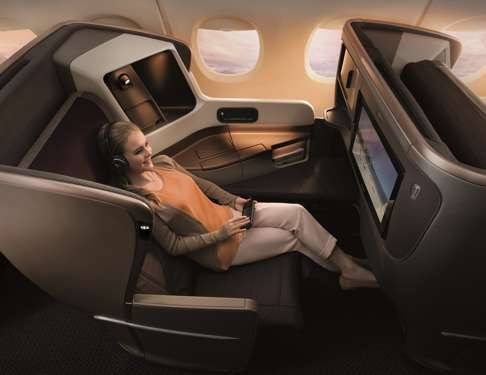
The future of in-flight entertainment has you in control via your mobile device
Stream Netflix or YouTube, preview and choose in-flight films before you board the plane and book a pick-up from the airport. All these will become reality as airlines bring new connected systems online
In-flight entertainment is back. And this time your smartphone is invited. After a few years where the best way to keep occupied on a plane was to take a tablet loaded with your own films and music – and completely ignore the tiny screen in the back of the seat in front – airlines are finally beginning to offer fully networked, connected systems that link to passengers’ own phones and tablets.
It’s about time. In the last five years tablets have become so common in cabins that airlines have left their inflight entertainment systems to age disgracefully, with limited, low resolution content displayed on LCD screens with embarrassingly narrow viewing angles and bleached out colours.
But with a new generation of in-flight entertainment platforms now coming online, it’s about to get personal, and in the long term, a lot more immersive.

Long before take-off, passengers can see a list of films and TV shows that will be available to them on a flight, watch trailers, and read reviews and synopses. The app even lets you select which films you want to see, so they are in the queue waiting for you when you find your seat.
However, as well as doubling as a remote control, the KrisWorld app also works as a second screen, allowing passengers to port to their phone or tablet a digital version of the in-flight magazine, the moving map, or the navigation screens for the entertainment system itself.
Air Canada rouge is going one better by allowing passengers to stream movies and TV shows straight from the in-flight entertainment system to their phone or tablet over a Wi-fi network in the cabin.
“We believe personalisation will be the one of the key trends in the in-flight experience,” says Paul Margis, president and chief executive of Panasonic Avionics, which created both systems.
“The symbiosis of the onboard in-flight entertainment network and travellers’ personal devices will be the key to a seamless travel process.”
The tech behind it is simple; onboard servers installed inside a jet’s electronics bay are linked to wireless access points mounted in the ceiling of the aircraft that can transmit customised entertainment.
For airlines, offering more connected in-flight entertainment systems is all about staying competitive in a cut-throat market. Having wireless entertainment systems and apps in the cabin is great, but what passengers really want is Wi-fi.
So far that’s been sporadic and unreliable, but it’s now possible to get internet speeds in the air similar to what we’re used to on the ground.
“In-flight Wi-fi will completely transform the passenger experience, allowing passengers to order duty free and arrange for items to be delivered straight to their homes, book last-minute Uber pick-ups, read TripAdvisor articles, and even connect with other tourists travelling to the same destination,” says Don Buchman, vice president and general manager of Commercial Mobility at satellite communications company ViaSat, one of the major providers of in-flight internet.

Although 13,000 commercial aircraft are predicted to offer in-flight connectivity to passengers by 2023, it’s not yet ubiquitous outside the continental United States, where there is a network of 3G ground stations.
A recent survey of US airline passengers by Honeywell Aerospace found that 84 per cent want a Wi-fi experience identical to what they have at home or in the office. Eighty-three per cent expect to be able to stream YouTube or Netflix while flying.
AeroMexico has already trialled a Netflix service for passengers, though for that kind of bandwidth-hungry activity to become common at altitude will require a whole new generation of satellites. Providers like ViaSat and Inmarsat are now launching new Ka-band satellites, which eventually provide up to 100 times the capacity of the existing Ku-band satellites.
Aviation connectivity company GoGo announced in August that it will work with China Telecom Satellite to offer Ku-band in-flight connectivity service on international flights operating in and out of China starting in October.
“For passengers on Gogo equipped flights currently flying into China, this means they will be able to enjoy seamless service once they reach Chinese air space,” says Michael Small, Gogo’s president and chief executive. GoGo has also signed up to equip Hainan Airlines and Beijing Capital Airlines with Ku-band internet.
However, don’t think that it’s only about streaming Netflix. Cathay Pacific announced in May that it would use its Ku-band connectivity to offer live TV channels as well as in-flight internet on its Airbus A350 fleet, though it’s limited to the BBC, CNN and Euronews channels.
Live TV is now being introduced by some in-flight entertainment companies, notably Panasonic’s eXTV television network. Available now on 13 airlines – including Emirates’ new Ice TV Live service – this is about live sports events.
Anyone who’s missed the big game to take a flight will see the appeal of live events being available on flights. The eXTV includes live broadcasts of the English Premier League and Uefa Champions League soccer as well as Formula 1 and NFL.
Services like live TV and Netflix will cost money; even current low-bandwidth in-flight Wi-fi is free only on a select few airlines, including Emirates, Turkish Airlines, Air China and Hong Kong Airlines. If Wi-fi will eventually follow the lead of hotels and become free to all, airlines will find other ways of charging for in-flight entertainment.

